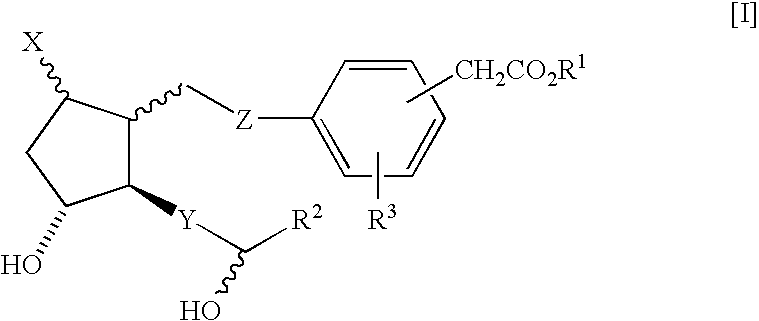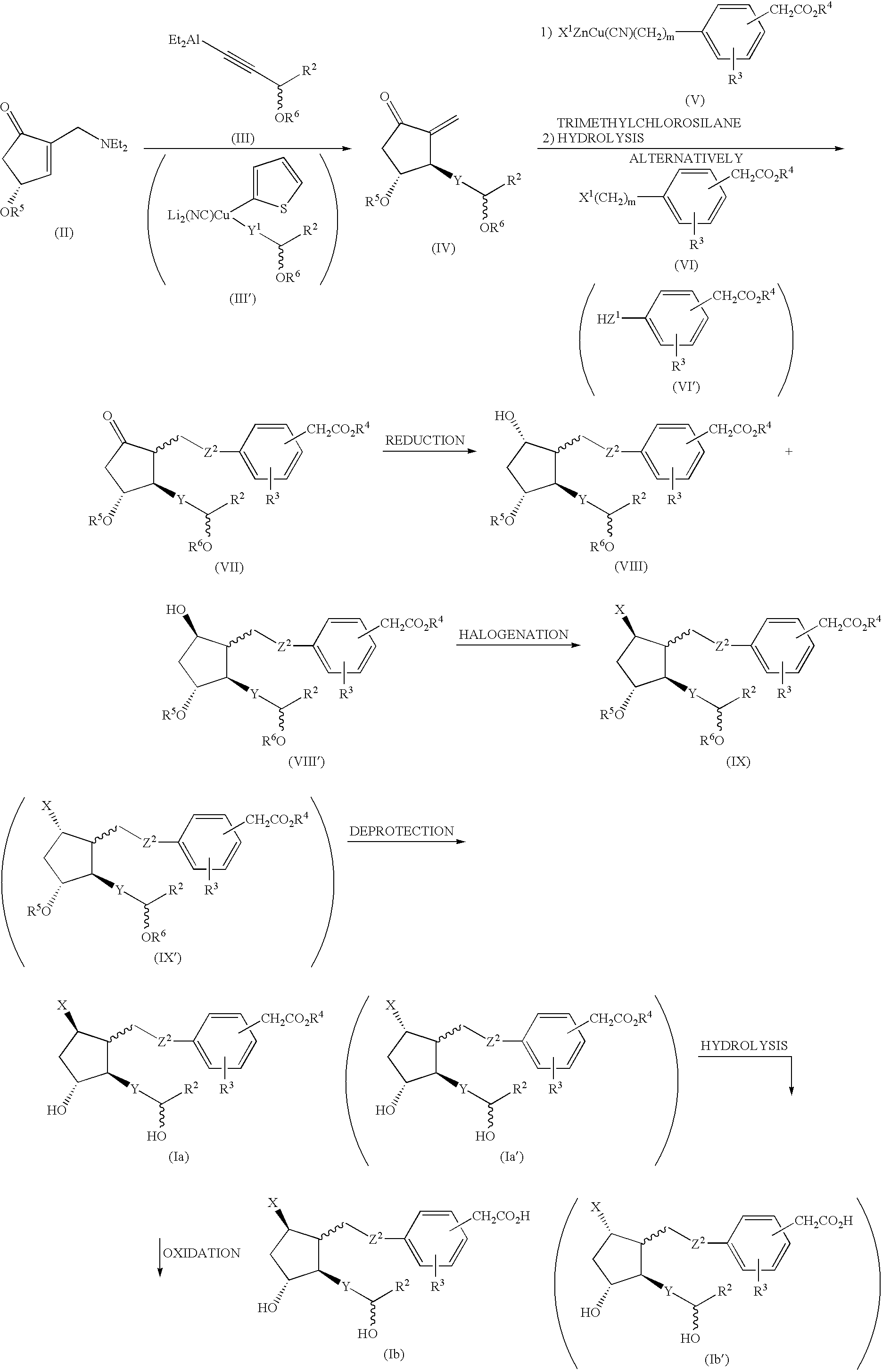Prostaglandin derivatives
a technology of prostaglandin and derivatives, applied in the field of prostaglandin derivatives, can solve the problem of inadequate action of prostaglandins
- Summary
- Abstract
- Description
- Claims
- Application Information
AI Technical Summary
Benefits of technology
Problems solved by technology
Method used
Image
Examples
example 1
9-Deoxy-9β-chloro-3,4,5,16,17,18,19,20-octanol-2,6-inter-m-phenylene-15-cyclohexyl-13,14-didehydro-PGF1α ethyl ester (Compound 37)
[0033] (1) (3S)-3-(tert-butyldimethylsiloxy)-3-cyclohexylprop-1-yne (16.4 g) was dissolved in 200 ml of toluene, and n-butyl lithium (2.46 M, hexane solution, 24.4 ml) was added at 0 degree C., followed by stirring at the same temperature for 30 minutes. Diethylaluminum chloride (0.93 M, hexane solution, 75.3 ml) was added to the solution at 0 degree C., followed by stirring for 30 minutes up to room temperature. (4R)-2-(N,N-diethylamino)methyl-4-(tert-butyldimethylsiloxy)cyclopent-2-en-1-one (0.25M, toluene solution, 200 ml) was added to the solution at room temperature followed by stirring for 15 minutes. The reaction solution was poured into a mixture of hexane (485 ml)—a saturated aqueous ammonium chloride solution (485 ml)—aqueous hydrochloric acid solution (3M, 140 ml) under stirring, and the organic layer was separated, which was washed with a sat...
example 2
9-Deoxy-9β-chloro-3,4,5,16,17,18,19,20-octanol-2,6-inter-m-phenylene-15-cyclohexyl-13,14-didehydro-PGF1α (Compound 38)
[0050] To a methanol (52 ml) solution of the compound (2.16 g) obtained in Example 1 was added water (5.2 ml) and lithium hydroxide monohydrate (1.08 g) followed by stirring at room temperature for 3 hours. The reaction solution was made weakly acidic using hydrochloric acid (2 M), salted out by addition of sodium hydrogen sulfate, extracted with diethyl ether, dried over anhydrous magnesium sulfate and filtered. The crude product obtained by concentration of the filtrate under reduced pressure was purified by a silica gel column chromatography (developing solvent; ethyl acetate) to give the title compound (2.08 g).
[0051]1H-NMR (CDC3, 300 Hz) δ ppm; 0.92-2.38 (m, 16H), 2.33 (ddd J=9.8, 6.71, 1.9 Hz, 1H), 2.70-2.89 (m, 2H), 3.61 (s, 2H); 3.80-5.10 (m, 5H), 4.16 (dd, J=6.1, 1.9 Hz, 1H), 7.05-7.29 (m, 4H).
[0052] IR(neat): 3390, 2929, 2854, 2664, 2237, 1715, 1609, 590...
example 3
9-Deoxy-9β-chloro-3,4,5,17,18,19,20-heptanol-2,6-inter-m-phenylene-16-cyclopentyl-13,14-didehydro-PGF1α ethyl ester (Compound 69)
[0053] (1) Following the substantially same manner as in Example 1(1) using (3S)-3-(tert-butyldimethylsiloxy)-4-cyclopentylbut-1-yne in place of (3S)-3-(tert-butyldimethylsiloxy)-3-cyclohexylprop-1-yne in Example 1(1), thereby (3R,4R)-2-methylene-3-[(3S)-3-(tert-butyldimethylsiloxy)-4-cyclopentylbut-1-ynyl]-4-(tert-butyldimethylsiloxy)cyclopentane-1-one was obtained.
[0054]1H-NMR(CDCl3, 300 MHz) δ ppm; 0.07-0.17(m, 12H), 0.89(s, 18H), 1.03-2.02(m, 11H), 2.33(dd, J=17.9, 7.6 Hz 1H), 2.71(dd, J=17.9, 6.4 Hz, 1H), 3.41-3.58(m, 1H), 4.22-4.31(m, 1H), 4.39(t, J=6.7 Hz, 1H), 5.55(d, J=2.4 Hz, 1H), 6.14(d, J=3.0 Hz, 1H)
[0055] IR(neat): 2930, 2850, 1735, 1638, 1460, 1360, 1245, 1220, 1100, 1000, 935, 825, 770 cm−1
[0056] (2) Following the substantially same manner as in Example 1(2) using the compound obtained in (1) above, thereby 3,4,5,17,18,19,20-heptanol-2,6...
PUM
 Login to View More
Login to View More Abstract
Description
Claims
Application Information
 Login to View More
Login to View More - R&D
- Intellectual Property
- Life Sciences
- Materials
- Tech Scout
- Unparalleled Data Quality
- Higher Quality Content
- 60% Fewer Hallucinations
Browse by: Latest US Patents, China's latest patents, Technical Efficacy Thesaurus, Application Domain, Technology Topic, Popular Technical Reports.
© 2025 PatSnap. All rights reserved.Legal|Privacy policy|Modern Slavery Act Transparency Statement|Sitemap|About US| Contact US: help@patsnap.com



